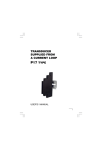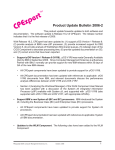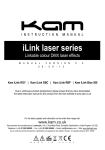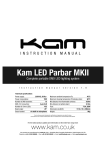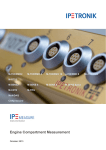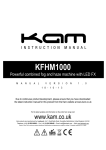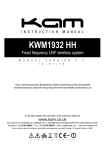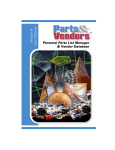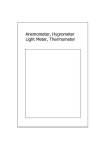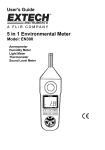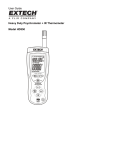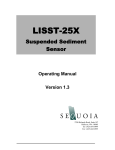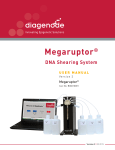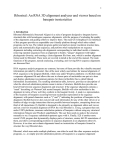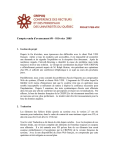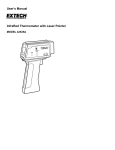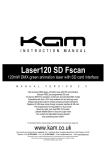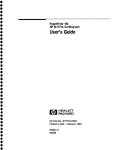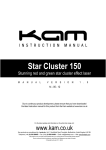Download ZSEQ: an interactive DNA sequence analysis program designed for
Transcript
608th MEETING, KEELE
1015
ZSEQ: an interactive DNA sequence analysis program designed for microcomputers
MARTIN J. BISHOP
Department of Zoology, University of Cambridge, Downing
Street, Cambridge CB2 3EJ. U.K.
VOl. 12
Starting
The package is intended to be self-documenting. In
answer to prompts the following should usually have the
desired effect :
? for help
control-Q to quit the current task
control-C to stop the program
Answers to prompts may be in upper or lower case letters.
Verifydna
This section checks for correct EMBL format of the
input. If the input is not in EMBL format, the input is
passed to EMBLFORMAT for conversion.
The sequence is then checked to ensure that it contains
only the characters specified in Appendix B.2 of the EMBL
manual. If there are characters in the input which do not
conform to the standard but for which equivalents exist, the
opportunity is given to convert them. A wild selection of
characters at this point indicates that some arbitrary piece
of text has been read in by mistake. Note that the Staden
(Staden, 1979) or other uncertainty codes are not accepted
by ZSEQ.
If the sequences are correct they are output for further
processing.
Emblformat
This section converts sequences to EMBL format.
A sequence without other information is converted by the
addition of an ID line, CC lines, FH line, FT lines, SQ line
and /I line.
Sequences is GENBANK or SEQ format are automatically converted to EMBL format so that they may be
processed by the program. However, the GENBANK
positional information is not converted to a feature table.
Identifiers in GENBANK or SEQ files may be up to 10
characters long. On conversion to EMBL format, identifiers
have to be truncated to eight characters, but the words
MADEFROM. (identifier) are included on the ID line. Any
clashes may therefore be distinguished even though they
have to be acessed by the same search key.
Automatic mode
Automatic mode is used to process input files containing
a large number of ID entries. Such files might typically
contain homologous genes from a variety of organisms, or
genes sliced from a single genome using the Filing option in
manual mode operating on the EMBL FT lines. Terminal
output is minimal in automatic mode, ID lines being
reflected to keep track of processing.
Sequences are treated as linear molecules and are
processed from position 1 to the // line of each ID entry.
Downloaded from https://portlandpress.com/biochemsoctrans/article-pdf/12/6/1015/493644/bst0121015.pdf by guest on 19 June 2020
ZSEQ is a self-documenting interactive DNA sequence
analysis package designed for small computers based on
280 microprocessors. The SZEQ philosophy is to provide
basic operations which can be economically performed on
small machines. ZSEQ is written in BCPL, a language
which has been carefully designed to be near optimal for
flexible text-processing applications (Richards & WhitbyStrevens, 1979).
ZSEQ provides counting, listing, translating, filing,
splicing and pattern-finding facilities. ZSEQ does not
provide searches for genes, secondary structure determinations nor comparisons of two or more sequences, activities
which are best carried out on larger machines.%
The only sequence length limitation on the programs is
the value of the maximum integer held in one word of the
BCPL implementation. (On the Z80 this is 32766.)
ZSEQ is designed to work on input files in EMBL format
and the program should be used in conjunction with the
EMBL Nucleotide Sequence Data Library User Manual
(‘EMBL manual’) (Cameron et al., 1983).
Each entry in the EMBL database corresponds to a single
sequence, and an entry is structured so that it can be easily
read by humans or machines. Each entry is composed of
lines, the first two symbols in a line indicating its type. An
entry is identified by its ID line which carries a unique
eight-letter identifier. Information lines follow, particularly
notable being the FT lines which locate the features of
importance such as exons and introns. The start of the
sequence itself is after the SQ line and the entry is
terminated by the // line. Input files to ZSEQ may contain
multiple ID entries, so that automatic processing of many
sequences is made possible. The option is also provided to
select individual ID entries from a file containing many
sequences.
ZSEQ will also work on an input file containing a
sequence alone, or will extract multiple sequences from
input files in SEQ or GENBANK formats. It will not
convert the GENBANK sequence positions into an EMBL
features table.
ZSEQ always verifies the symbols present in sequences,
and has facilities for alteration of unrecognized symbols to
the set defined in Appendix B.2 of the EMBL Manual. The
symbol # may be used to pad aligned sequences [note that
the symbol - (hyphen) cannot be used for this purpose as it
means any of A, C, G, or TI.
The output from ZSEQ will be either sequences in EMBL
format suitable for storage on disc for further processing or
output suitable for printing.
ZSEQ is divided by function into four activities:
(1) Counting: counts may be made of bases, doublets,
triplets, oligonucleotides of up to six in length, and codons.
(2) Filing: output may be sent to disk for further
processing. Formatting, splicing, complementation, reverse
complementation and translation may be performed.
(3) Listing: sequences may be listed with position
numbers as single or double-stranded DNA or translated in
up to six reading frames.
(4) Patternfinding: partial or total matches to an input
pattern may be found in one or both strands.
When running in automatic mode, ZSEQ will process
each ID entry in a file from position 1 to the // line. This
allows rapid processing with minimal effort. In manual
mode each individual ID entry may be selected, and then
parts of the sequence may be further selected by position
numbers. If a sequence is specified to be circular, reading
over the physical endlbeginning of the sequence may be
performed.
Part of the additional power of ZSEQ over other analysis
systems comes from its exploitation of the EMBL features
table. Selecting the F option in manual mode enables the FT
lines to be read by the program. The FT lines in the current
ID entry are displayed by typing the symbol ? in response to
the prompt for a key name. Feature table key names
(Appendix A of the EMBL manual) may be selected to
simplify specific tasks. For example, by selecting the key
name CDS gene splicing may be performed with the introns
discarded. This facility is available in all parts of the
package, not merely for file output.
1016
Counting
Programs are available to count bases, to count overlapping doublets, to count overlapping triplets and to count
non-overlapping triplets to give codon frequencies. In
manual mode, typing ‘ + ’ accumulates sums of sums until
the next ‘N’ is typed.
When counting the base sum, the numbers of individual
characters A, C, G, T, R,Y, N and # (Appendix B.2 of the
EMBL manual) in the sequence are recorded as well as the
numbers of purines (A + G + R), pyrimidines (C +T + Y)
and all bases. U is treated as T, and the lower case letters as
their upper case equivalents.
When counting doublets or triplets the deletion character
# is ignored. If ambiguous characters (R, Y, N) are
encountered, counts involving them are discarded.
When counting codons the deletion character is ignored,
and any non-overlapping triplet involving ambiguous
characters is discarded.
Oligonucleotides of lengths between four and six bases
may also be counted, though the output may be voluminous.
Filing
The filing programs take sequences in EMBL format and
output altered sequences in EMBL format to disc.
Selected parts of the sequences may be output. In
addition complementation, inversion and translation operations are available.
This section makes it very straightforward to output the
genes from longer sequences using the EMBL FT lines. For
example, by selecting the key name TRNA all tRNA genes
may be output. By selecting the key name CDS and using
the ‘N’ and ‘ + ’ controls, any type of RNA processing may
be undertaken, with or without translation.
Note that if the qualifier (C) is set the output sequence
fragment is complemented but not inverted.
The inversion operation is limited by the memory size of
the machine. If this proves to be a problem, fragments may
be inverted and the concatenated in the appropriate order.
Listing
DNA may be listed with position numbers as a single or
double strand. Translation in all six reading frames may be
added.
When DNA is listed without translation the standard
output has 60 bases per line. This may be optionally altered
to between 10 and 120 bases per line (in multiples of 10).
When DNA is listed with translation the line length is 45
bases giving 15 amino acids per line. Amino acids may be
written in the three-letter or single-letter codes.
Pattern jnding
Patterns of up to lo00 bases may be supplied. Patterns
may contain ambiguous characters (N, R, Y). Matching is
one sided: unambiguous bases in the pattern not being
matched by ambiguous bases in the sequence. For example,
Y in the search pattern will match T, C or Y in the sequence,
whereas Y in the sequence will not be matched to T in the
pattern.
In automatic mode a disk file of sequences in EMBL
format is used to input the patterns. In manual mode each
pattern is input at the terminal as required. Up to 80 bases
may be typed, input being terminated by carriage return.
If a search for total matches is requested the output is in
the form of position numbers. Matches in the complementary strand are marked by *.
Output from a search for partial matches displays the
pattern and the portion of the sequence, with matches
marked by colons.
Circular sequences have to be declared in manual mode
in order that the physical endlbeginning of the sequence
may be searched. Negative position numbers mark the start
of the match near the physical end of the sequence. Thus -2
is the position three bases before the end of the sequence.
Translation
Translation is available in both the Filing and Listing
sections. The nuclear or mammalian mitochondria1 codes
are provided. In addition the user may alter either of these
to the code table appropriate for other sequences. All that is
necessary is to type the codons and the altered amino acid
symbols which they represent.
Translated output may be in one-letter (Dayhoff) or
three-letter codes. Codons involving ambiguous base
symbols (R, Y, N) are always translated if possible,
otherwise the symbol X (Xxx) is output. (Note that the
aspartic and glutamic uncertainties are translated as X.)
When translating a gene with codons which are internally
split by introns it is necessary to first output the DNA of the
coding region and then to translate it. The translation
programs do not automatically take care of this situation.
Implementation
ZSEQ has been implemented under a 64K CP/M
operating system using the BCPL compiler described by
Wilson & Webster (1980) and supplied by F. FretwellDowning Ltd. The executable code should run on any
machine which has the CP/M operating system. The
package is arranged with a main menu and seven overlay
segments.
Though ZSEQ has been designed for a machine with
limited memory, it will be easy to implement on any system
1984
Downloaded from https://portlandpress.com/biochemsoctrans/article-pdf/12/6/1015/493644/bst0121015.pdf by guest on 19 June 2020
Manual mode
Manual mode is used to process individual ID entries.
The sequence may be accessed either by position numbers
or from the FT lines.
An ID entry is accessed by giving its short identifier. This
may be specified in lower case letters which will be
converted to upper case by the program. Note that EMBL
short identifiers must be in upper case. If a ? is typed instead
of an identifier, a listing of the ID lines in the input file is
displayed on the screen.
The DNA sequence may be treated as a circular molecule
or a linear fragment. In the former case it is possible to read
past the end of the sequence, as it appears on paper, into the
beginning.
The format for giving sequence positions is ‘From’, ‘To’,
‘Qualifier’. Normally ‘From’ is less than ‘To’ and the
‘Qualifier’is blank. If ‘From’ is equal to ‘To’ a single base at
that position is specified. If ‘From’ is downstream relative
to ‘To’ and the qualifier is (C), the complementary strand is
specified. These conventions follow the EMBL manual.
When specifying sequence positions at the terminal the
entries may be separated by spaces or commas. The
abbreviations . (full stop) and * (asterisk) are available to
represent the current cursor position and the end of the
sequence respectively.
The input FT lines have to be in the fixed format
specified by the EMBL manual. Otherwise the sequence
positions are read in the same way as from the terminal. In
addition an FT key name (Appendix A of the EMBL
manual) may be selected. The key name may be typed in
upper or lower case letters. Lower case will be converted to
upper case by the program. Note that in EMBL files the key
name has to be in upper case. To step through the FT lines
‘ - ’ is typed at the terminal. Typing ‘N’ starts a new output
entry and typing ‘+’ adds results to the previous output.
BIOCHEMICAL SOCIETY TRANSACTIONS
608th MEETING, KEELE
for which a BCPL compiler exists. It has been implemented
unaltered, except for a small machine-dependent section, on
an IBM 308 1 computer under the MVS operating system.
On this machine the BCPL word length is 32 bits, and
ZsEQ
process DNA sequences Of length up to
2147483647 bases*Because the sequence
are accessed
by virtual I/O, also used on this machine to move arrays in
and out of main store, the response is very fast.
1017
Cameron, G., Hamm, G., Nial, J., Rudloff, A., Stoesser, G. &
Stueber, K.(1983) EMBL Nucleotide Sequence Data Library User
Manual, European Molecular Biology Laboratory, Heidelberg
Richards, M.8~Whitby-Strevens, C. (1979) BCPL-the Language
and its Compiler, Cambridge University Press, Cambridge
Staden, R. (1979) Nucleic Acids Res. 6, 260-2610
Wilson, I. D. & Webster, C. A. (1980) 280 BCPL System for CPIM
and cDos,F. Fretwell-Downing Ltd., Sheffield
ZPEP: an interactive protein sequence analysis program designed for microcomputers
MARTIN J. BISHOP
Department of Zoology, University of Cambridge, Downing
Street, Cambridge CB2 3EJ, U.K.
Counting
Programs are available to count amino acids, to count
overlapping doublets and to count overlapping triplets. In
manual mode, typing ' + ' accumulates sums of sums until
the next 'N' is typed.
When counting doublets or triplets the deletion character
// is ignored. If ambiguous characters (B, Z, X) are
encountered, counts involving them are discarded.
Filing
The filing programs take sequences in EMBL format and
output altered sequences in EMBL format to disk.
Selected 'parts of the sequences may be output. In
addition reverse translation is available.
Listing
Proteins may be listed with position numbers and reverse
translation may be added.
VOl. 12
Pattern finding
Patterns of up to 100 amino acids may be supplied.
Patterns may contain ambiguous characters (B, Z, X).
Matching is one sided: unambiguous amino acids in the
pattern not being matched by ambiguous amino acids in the
sequence. For example, B in the search pattern will match
D, N or B in the sequence, whereas B in the sequence will
not be matched to D in the pattern.
In automatic mode a disk file of sequences in EMBL
format is used to input the patterns. In manual mode each
pattern is input at the terminal as required. Up to 80 amino
acids may be typed, input being terminated by carriage
return.
If a search for total matches is requested the output is in
the form of position numbers.
Output from a search for partial matches displays the
pattern and the portion of the sequence, with matches
marked by colons.
Reverse translation
Reverse translation is available in both the Filing and
Listing sections. The nuclear or mammalian mitochondria1
codes are provided. In addition the user may alter either of
these to the code table appropriate for other sequences. All
that is necessary is to type the codons and the altered amino
acid symbols which they represent. Reverse-translated
output contains the Staden uncertainty codes (Staden,
1979):
R for A or G
Y for C or T
5 for A or C
6 for G or T
7 for A or T
8 for G or C
-for A or C or G or T (or any three out of the four.
Ambiguous amino acids (B, Z, X) are not translated but the
symbols ??? are output.
Cameron, G., Hamm, G., Nial, J., Rudloff, A., Stoesser, G. &
Stuber, K. (1983) EMBL Nucleotide Sequence Data Library User
Manual, European Molecular Biology Laboratory, Heidelberg
Staden, R. (1979) Nucleic Acids Res. 6, 2601-2610
Downloaded from https://portlandpress.com/biochemsoctrans/article-pdf/12/6/1015/493644/bst0121015.pdf by guest on 19 June 2020
ZPEP is a self-documenting interactive protein sequence
analysis package designed for small computers based on
Z80 microprocessors.
ZPEP provides counting, listing, reverse translating,
splicing and pattern-finding facilities. ZPEP does not
provide secondary structure determinations nor comparisons of two or more sequences.
ZPEP is designed to work on input files in EMBL format
but will also work on an input file containing a sequence
alone, or will extract multiple sequences from input files in
SEQ or GENBANK formats.
Input sequences should be in the one-letter code for
amino acids. ZPEP always verifies the symbols present in
sequences, and has facilities for alteration of unrecognized
symbols to the set defined by IUPAC-IUB and given in
Appendix B.4 of the EMBL Nucleotide Sequence Data
Library User Manual ('EMBL manual') (Cameron et al.,
1983). The symbol // may be used to pad aligned sequences.
The output from ZPEP will be either sequences in EMBL
format suitable for storage on disc for further processing or
output suitable for printing. Output may be in the one-letter
or the three-letter code.
ZPEP is divided by function into four activities:
(1) Counting: counts may be made of amino acids,
doublets and triplets.
( 2 ) Filing: output may be sent to disk for further
processing. Formatting, splicing and reverse translation
may be performed.
(3) Listing: sequences may be listed with position
numbers in the one-letter or the three-letter code with
reverse translation.
(4) Putternfinding: partial or total matches to an input
pattern may be found in one or both strands.
When proteins are listed without translation the standard
output has 60 amino acids per line. This may be optionally
altered to between 10 and 120 amino acids per line (in
multiples of 10).
When proteins are listed with translation the line length is
20 amino acids giving 60 nucleotides per line. Amino acids
may be written in the three-letter or the single-letter code.




